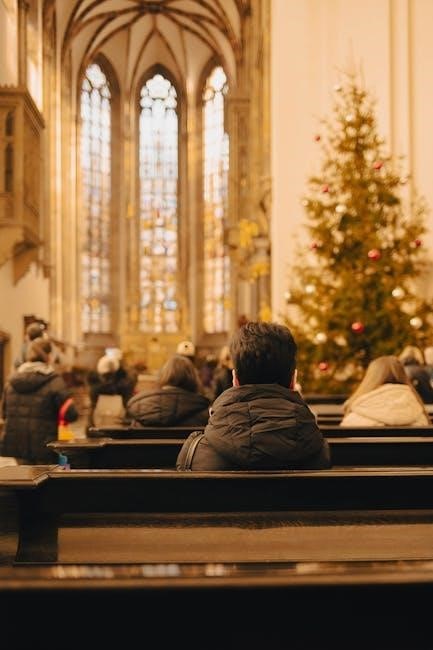Origin and History of the Christmas Proclamation
The Christmas Proclamation, rooted in the Roman Martyrology, traces its origins to early Christian tradition, announcing Christ’s birth with historical and theological depth, evolving over centuries in liturgical practice.
1.1 The Roman Martyrology and Its Significance
The Roman Martyrology is the official catalogue of saints and martyrs of the Catholic Church, read on their feast days. For Christmas, it provides the text for the Proclamation, situating Christ’s birth within salvation history. This ancient document, read on December 24, highlights the theological significance of Jesus’ incarnation, linking it to biblical prophecy and history. While traditionally in Latin, English translations like the 2011 ICEL version are now widely used, preserving its liturgical and devotional importance.
1.2 Historical Development of the Christmas Proclamation Chant
The Christmas Proclamation chant has its roots in early Christian liturgy, evolving from ancient martyrological readings. Originally sung in Latin, it was part of the liturgical tradition, announcing Christ’s birth during Midnight Mass. Over centuries, the chant developed into a formal proclamation, blending biblical history and theological significance. Modern adaptations, such as the 2011 ICEL English version, maintain its essence while making it accessible to contemporary congregations, preserving its historical and liturgical importance in the celebration of Christmas.

The Role of the Christmas Proclamation in Midnight Mass
The Christmas Proclamation is traditionally chanted or recited at the beginning of Midnight Mass, formally announcing Christ’s birth. It sets the liturgical tone, enriching the celebration with theological depth and historical context, while complementing the Eucharistic rites without replacing any essential parts of the Mass.
2.1 Placement Within the Liturgy
The Christmas Proclamation is traditionally placed at the beginning of the Midnight Mass or during the Liturgy of the Hours on Christmas Eve. It is chanted or recited after the introductory rites, setting the tone for the celebration. The proclamation formally announces Christ’s birth, situating it within sacred history and theological context. It is often sung before the Gloria, enhancing the liturgical atmosphere without replacing any essential parts of the Mass, ensuring its integral role in the Christmas liturgy.
2.2 Traditional vs. Modern Practices
Traditionally, the Christmas Proclamation is chanted in Latin, often during Midnight Mass, maintaining its historical and theological roots. Modern practices incorporate English translations and contemporary musical arrangements, making it accessible to a broader audience. Digital resources, such as PDF downloads from MusicaSacra and Saint Meinrad Archabbey, facilitate its use in various liturgical settings, blending tradition with modern accessibility.

Language Versions of the Proclamation
The Christmas Proclamation is available in multiple languages, with the Latin version traditionally used at the Vatican and English translations widely adopted. PDF resources from MusicaSacra and Saint Meinrad Archabbey provide accessible versions for global use.
3.1 Latin Version and Its Use at the Vatican
The Latin version of the Christmas Proclamation, rooted in the Roman Martyrology, is traditionally sung at the Vatican during Midnight Mass. This ancient text, chanted in Latin, situates Christ’s birth within salvation history, emphasizing its theological significance. The Vatican’s use of the Latin version underscores its liturgical heritage and universal appeal. A PDF of the Latin chant score is available from MusicaSacra, preserving its traditional melody and enabling global access to this sacred liturgical practice.
3.2 English Translations and Their Adoption
The Christmas Proclamation is also available in English, with translations approved by the International Commission on English in the Liturgy (ICEL). The 2011 English version aligns with the traditional Latin tone, maintaining theological richness. Parish communities worldwide adopt this translation, integrating it into Midnight Mass and Liturgy of the Hours. PDF resources, such as those from MusicaSacra and Saint Meinrad Archabbey, offer downloadable English chant scores, facilitating its widespread use in contemporary worship settings.

Musical Settings and Chant Traditions
4;1 The Traditional Melody and Its Characteristics
The traditional melody of the Christmas Proclamation is a solemn, chant-like composition rooted in Gregorian tradition. Its dignified tone reflects the liturgical significance of the text, drawing worshipers into the mystery of Christ’s birth. The melody, often sung in Latin, features a hauntingly beautiful simplicity that underscores the theological depth of the proclamation.
Historically used in midnight Masses, this melody has been preserved and cherished, embodying the timeless essence of the chant tradition. Its use at the Vatican and other liturgical centers highlights its enduring relevance in sacred worship.
The traditional melody of the Christmas Proclamation is a solemn, chant-like composition rooted in Gregorian tradition. Often sung in Latin, it features a dignified and hauntingly beautiful simplicity that underscores the theological depth of the text. Historically used in Midnight Masses, this melody has been preserved and cherished, embodying the timeless essence of the chant tradition. Its use at the Vatican and other liturgical centers highlights its enduring relevance in sacred worship.
4.2 Modern Arrangements and Interpretations
Modern arrangements of the Christmas Proclamation blend traditional melodies with contemporary harmonies, preserving its sacred essence while appealing to diverse congregations. Digital resources like PDF scores from MusicaSacra and Saint Meinrad Archabbey offer accessible versions, including multilingual adaptations. The 2011 ICEL English text, set to the traditional Latin tone, exemplifies this fusion. These interpretations ensure the chant remains relevant, adapting to cultural and liturgical evolutions while maintaining its timeless spiritual impact and theological significance.

PDF Resources and Downloads
PDF resources for the Christmas Proclamation, including chant scores and texts, are widely available from sources like MusicaSacra and Saint Meinrad Archabbey, offering Latin and English versions.
5.1 MusicaSacra and Their Contributions
MusicaSacra is a leading resource for liturgical music, offering high-quality PDFs of the Christmas Proclamation chant. Their collection includes traditional Latin scores and modern English adaptations, such as the ICEL translation. These PDFs are freely accessible, providing singers and parishes with accurate and beautiful renditions of the Proclamation. MusicaSacra’s contributions are invaluable for preserving and sharing liturgical chant traditions, ensuring the Proclamation remains a vibrant part of Christmas celebrations worldwide.
5.2 Saint Meinrad Archabbey’s Liturgical Music
Saint Meinrad Archabbey is renowned for its rich liturgical music resources, including the Christmas Proclamation. They offer a compact disk, Gregorian Chant for Advent & Christmas, featuring Latin and English chants. Additionally, a 198-page PDF is available for download, containing traditional and contemporary settings of the Proclamation. Their contributions ensure the chant remains accessible and authentic, supporting parishes and individuals in celebrating the liturgy with fidelity and beauty during the Christmas season.

Liturgical Significance and Spiritual Impact
The Christmas Proclamation is a liturgical highlight, chanted or recited during Midnight Mass, proclaiming Christ’s birth with theological richness, deepening spiritual reflection and joy in the Incarnation.
6.1 The Proclamation Text and Its Theological Depth
The Christmas Proclamation text, drawn from the Roman Martyrology, situates Christ’s birth within salvation history, emphasizing His divine and human nature. It reflects on creation, sin, and redemption, highlighting Christ as Messiah and Savior. Theological themes include Incarnation, grace, and the fulfillment of prophecy. Its rich imagery and historical context deepen worshipers’ understanding of Christmas, connecting the event to God’s eternal plan. The text’s depth invites contemplation on the mystery of God becoming human, central to Christian faith.
6.2 Timing and Context in the Christmas Liturgy
The Christmas Proclamation is traditionally chanted or recited near the beginning of Midnight Mass or during the Liturgy of the Hours on Christmas Eve. Its placement sets the tone for the celebration, situating Christ’s birth within salvation history. The text connects the congregation to the mystery of the Incarnation, emphasizing the transition from darkness to light. This liturgical moment prepares the faithful to embrace the spiritual significance of Christmas, fostering a deeper reflection on God’s love and redemption.

Modern Adaptations and Digital Sharing
The Christmas Proclamation is now widely shared through digital platforms, with PDF downloads from sources like MusicaSacra and Saint Meinrad Archabbey, enhancing accessibility for modern worshippers globally;
7.1 Online Availability and Accessibility
The Christmas Proclamation is widely available online, with PDF downloads from sources like MusicaSacra and Saint Meinrad Archabbey, making it easily accessible for global worshippers. These digital resources provide both Latin and English versions, ensuring the chant can be used in various liturgical settings. The internet has revolutionized the sharing of liturgical music, enabling churches and individuals to download and print the Proclamation effortlessly. This accessibility has fostered its use in contemporary worship, bridging tradition with modern technology.
7.2 Creative Uses in Contemporary Worship
The Christmas Proclamation is increasingly integrated into modern worship, with churches adapting it as a hymn or procession chant. Trinity Church Wall Street uses it as a Gloria substitute, while others blend it into multicultural services. Saint Meinrad Archabbey incorporates it into Gregorian chant collections, showcasing its timeless appeal. Digital sharing has inspired creative arrangements, allowing the Proclamation to resonate in diverse liturgical contexts, from traditional masses to contemporary gatherings, enriching worship experiences worldwide.
The Christmas Proclamation remains a vital liturgical tradition, bridging history and modern worship. Its rich theological depth and adaptability ensure its enduring presence in Catholic liturgy and devotion worldwide.
8.1 The Enduring Legacy of the Christmas Proclamation
The Christmas Proclamation holds a timeless significance, rooted in the Roman Martyrology and enriched by centuries of liturgical tradition. Its theological depth and musical beauty have made it a cornerstone of Christmas worship globally. Available in Latin, English, and other languages, it bridges ancient and modern practices, ensuring its relevance in contemporary liturgy. Resources like MusicaSacra and Saint Meinrad Archabbey’s PDFs further its accessibility, preserving its legacy for future generations and maintaining its spiritual impact worldwide.
8.2 Its Role in Preserving Liturgical Tradition
The Christmas Proclamation preserves liturgical tradition by maintaining its historical chant and theological richness. Rooted in the Roman Martyrology, it connects modern worship to ancient practices. Institutions like MusicaSacra and Saint Meinrad Archabbey provide PDF resources, ensuring its authentic transmission and educational value. This balance of tradition and accessibility allows the Proclamation to remain a vital part of Christmas liturgy, fostering spiritual continuity across generations.




About the author